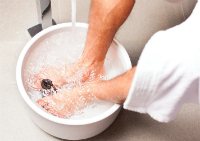NOVEMBER 2016
WHAT’S NEW
SIMPLE GUIDELINES FOR PREVENTING & MANAGING DIABETES

Type-1 DM is a chronic health condition in which the immune system ravages the insulin-producing cells of the pancreas, causing a loss of the hormone insulin and affecting the way glucose is metabolized. Because of the loss of insulin, the body cannot move glucose from the blood into the cells where it is needed. Instead, glucose levels run high in the blood causing system-wide damage. While holistic health approaches can support the body, there is no cure; life-long management REQUIRES insulin.
Type-2 DM develops from lifestyle choices. A highly preventable disease, it was once most common in middle-aged and older people. Today, it strikes an alarming number of young adults and children. It’s directly related to poor eating and exercise habits, which typically results in being overweight – a risk factor for Type-2 DM. In this type of diabetes, your body produces insulin but does not recognize and use it properly. If health is not restored through diet, lifestyle changes, and holistic approaches, Type-2 DM can progress to a state in which insulin is required.
Pre-diabetes is your warning sign, a condition in which your blood glucose level is chronically above normal, but not yet high enough to be diagnosed as Type-2 DM. This is your chance to stop the onset of diabetes in its tracks by improving your lifestyle choices.
A FEW SIMPLE GUIDELINES CAN HELP YOU MANAGE DIABETES, AND EVEN PREVENT TYPE-2 DM:
- Eat fresh whole foods, drink plenty of water, increase dietary fiber and the amount of dark fruits and veggies in your daily diet. Avoid processed foods and added sugars
- Exercise 30 minutes per day
- Supplement with a good multivitamin/mineral, EFA and B-vitamin complex
- Consult with a registered dietician to learn how to plan and prepare healthy meals
- Ask your practitioner about food allergy testing
- Keep your skin healthy (hydration and whole foods)
- Use natural remedies such as herbal supplements, vitamins, detoxification, and dietary adjustments under the supervision of a holistic physician
- Take medications or supplements as directed by your doctor
- Take particular care of your feet. Carefully monitor wounds, because many people with DM experience poor circulation and neuropathy
SUGAR’S ADDICTIVE QUALITIES
When we ingest sugar, our body generates a response similar to that seen in addictions, which is why we develop cravings for more. It’s often called the cocaine of dietary additives.
Here’s how it works: Sugar — whether natural, processed or artificial — enters the bloodstream quickly, causing your blood sugar level to spike. The body recognizes this imbalance and acts to bring blood sugar back to normal. Insulin, a hormone, pushes glucose into the cells to be used for energy. But if you eat a lot of sugar, the body can’t keep up. Insulin has to work harder and the body overcompensates, causing blood sugar to drop too low – and your brain reacts. You feel depleted, irritable, and crave more sugar.
SUGAR BY ANY OTHER NAME
Sugar names you might recognize are sucrose (table sugar), fructose (found in fruits, some root veggies, and honey), and lactose (milk sugar). Naturally occurring sugar in fruit and vegetables has a place in a balanced diet. But added sugar, artificial sweetener, and processed ‘natural’ sugar like high fructose corn syrup are detrimental to your health.
ELIMINATE UNHEALTHY SUGAR FROM YOUR DIET
Learn where Sugar Hides. On ingredient lists, look for words ending in ‘-ose,’ which equate to sugar. If they’re among the first five items, it’s not worth buying. When sugar is among the last items in the list, that’s a better choice.
AVOID THE FAKE STUFF. Products containing artificial sweeteners are not a healthy alternative. Diet soda, ‘fat free’ and ‘sugar free’ candy and cookies are associated with weight gain and cravings, creating a cycle of addiction.
SIP WITH AWARENESS. A single can of soda, flavored water, Gatorade, or a juice box typically contain nine or more teaspoons of sugar.
MAKE SWEET SUBSTITUTIONS. Look for snacks labeled ‘no added sugar’ or ‘unsweetened.’ Use canned foods packed in water or natural juice. When baking, swap table sugar with applesauce, date paste, molasses, or fruit puree. Cinnamon or vanilla powder is a great way to sprinkle flavor onto yogurt, oatmeal, or coffee. Opt for coconut sugar or syrup, brown rice syrup or cane sugar over other processed sugars.
Reprogram your sugar meter slowly. If you put two sugar packets in your coffee, cut back in half-packet increments. Keep sugar off the kitchen table. Small steps add up to sweet success!
REFERENCES
- Murray, M.T., “Diabetes Mellitus” in Pizzorno, Joseph E. (2013). Textbook of Natural Medicine. St. Louis, MO Elsevier. p. 898; 1340; (chapter 161), 1320-1348.
- National Institutes of Health. Diabetes.
FOOD FOR THOUGHT. . .
“Your imagination is your preview to life’s coming attractions.”
– Albert Einstein
LOVE THOSE LENTILS

You can find lentils in the bulk bin aisle or in prepackaged containers. When purchasing in bulk, try to buy organic and make sure there is no moisture in the bin or in the packaging. Look for whole, not cracked lentils. Store them in an airtight container in a cool, dark and dry place. They will keep up to a year. When buying canned lentils, watch for added salt or other preservatives. Unlike other canned veggies, lentils do not lose much of their nutritional potency.
Lentils are easy to prepare (no presoaking required as with other dry beans, although I soak mine for a couple hours anyway). Wash and strain lentils under cool water before cooking. You can boil lentils and store in the fridge for later use in casseroles, soups, rice or pasta dishes, salads, spreads/hummus, or soups. Cooked lentils stay fresh in the fridge in a covered container for about three days.
Sprouted lentils are also make a great protein dense addition to any meal, especially salads, sandwiches, soups and stew. Sprouted lentils are more nutrient dense than cooked lentils.
REFERENCES
- Future of Food: Pulses & Nutrition. Accessed on 6 Sep. 2016.
- Video: NutritionFact.org. “Diabetics Should Take Their Pulses.”
- Helmstadter, A. “Antidiabetic Drugs used in Europe Prior to the Discovery of Insulin.” Pharmazie (2007) 62(9):717 – 720.
- MedicalNewsToday.com. Accessed 6 Sep. 2016.
- World’s Healthiest Foods: Lentils. Accessed 6 Sep. 2016.
- Singhal, P., Kaushik, G., Mathur,P. “Antidiabetic Potential of Commonly Consumed Legumes: A Review.” Crit Rev Food Sci Nutr (2014) 54(5):655 – 672. Accessed 6 Sep 2016.
RECIPE: COCONUT CURRY LENTIL SOUP
Serves 4
- 1 tbsp coconut oil (or olive oil)
- 1 large onion, chopped
- 2 cloves garlic, minced
- 1 tbsp fresh ginger, minced
- 2 tbsp tomato paste
- 2 tbsp curry powder
- ½ tsp hot red pepper flakes
- 4 cups vegetable broth
- 1 400ml can coconut milk
- 1 400g can diced tomatoes
- 1.5 cups dry red lentils
- 2-3 handfuls of chopped kale or spinach
- salt and pepper, to taste
- Garnish: chopped cilantro (fresh coriander) and/or vegan sour cream

May be cooled, frozen in air-tight containers, and re-heated over medium-low heat.
Photo Credit and Recipe is from Vegangela.
TRIPLE THREAT AGAINST DIABETES: ALPHA LIPOIC ACID, CHROMIUM, & VANADIUM

ALPHA-LIPOIC ACID (ALA)
Within the body, Alpha-lipoic acid is found in every cell, where it helps turn glucose into energy. People with Type-2 diabetes take ALA supplements to help their body use insulin more efficiently, as well as protect against cell damage and diabetic neuropathy. Food sources include liver, lean red meat, spinach, broccoli, and potatoes.
CHROMIUM
Chromium helps cells make efficient use of glucose. Without chromium, insulin’s action is blocked and glucose levels increase. Chromium deficiency may be a factor in the number of Americans who have diabetes. A chromium supplement can lower fasting blood glucose levels, improve glucose tolerance, decrease insulin resistance, and decrease total cholesterol and triglyceride levels while increasing HDL-cholesterol levels. Food sources include meat, fish and fruits.
VANADIUM
Vanadium supports the body’s use of carbohydrates by improving how cells respond to insulin. Prior to the discovery of insulin in 1922, vanadium was used to control blood glucose. While modern conventional medicine does not recognize vanadium as an essential element in diabetes treatment, available studies suggest that the supplement does have a positive effect on blood glucose levels. Holistic practitioners carefully monitor their patients who supplement with vanadium. Food sources include mushrooms, shellfish, parsley, dill weed, unfiltered extra virgin olive oil, and grain products.
REFERENCES
- University of Maryland Medical Center Complementary & Alternative Medicine Guide Online. “Alpha-Lipoic Acid.” Accessed 7 Sep 2016.
- Ceriello A. “New Insights on Oxidative Stress and Diabetic Complications May Lead to a “Causal” Antioxidant Therapy.” Diabetes Care. (2003) 26:5, p.1589-96.
- Linus Pauling Institute Micronutrient Information Center. “Chromium.” Accessed 7 Sep 2016.
- University of Maryland Medical Center Complementary & Alternative Medicine Guide Online. “Vanadium.” Accessed 7 Sep 2016.
- Weston A. Price Foundation. “Treating Diabetes: Practical Advice for Combating a Modern Epidemic.”Accessed on 7 Sep 2016.
YOUR ORGANIC GARDEN

The foundation for organic gardening is biodiversity. In the wild, a variety of plants and wildlife exist interdependently-providing shelter, moisture, continual bloom when pollen is available for insects, and support for all the creatures within the system.
YOU CAN APPLY THE BIODIVERSITY PRINCIPLE AT HOME BY FOLLOWING THESE KEY STEPS IN ORGANIC GARDENING:
- Build-up the soil
- Use natural fertilizer and pest control
- Choose companion plants for your climate zone
- Arrange plants so they provide a habitat for insects and wildlife that actually benefit garden health
If you combine these principles with good gardening habits, you’ll soon have an organic green thumb (and lots of delicious, good-for-you vegetables to eat)!
IT’S NOT JUST DIRT!
What’s the difference between how the organic gardener feeds a garden compared to the conventional gardener? The conventional gardener feeds the plant (with chemicals from a lab), while the organic gardener feeds the soil.
Soil is living matter full of as many as 50 billion microscopic plants and organisms! Soil, and the creatures living in it, requires air and water to thrive. If you don’t know the condition of your soil, contact your local master gardening organization, or university agriculture department-both will usually test soil for free or a nominal fee. When buying soil, you want it largely composed of organic material (read the package label).
TO MAINTAIN AND PROTECT ORGANIC SOIL:
- Continually feed with organic matter-compost, manure, leaves, straw, and grass clippings
- Weed regularly
- Incorporate companion plants that naturally tame weed growth
- Check plant packaging or a regional organic gardening guide to learn how to properly select and space plants to best match the yield you want from your garden
- Use mulch
PROTECT AGAINST PESTS AND FERTILIZERS, NATURALLY
Synthetic herbicides and insecticides seep into groundwater, affect the health of wildlife and plants, and can contaminate your food. These chemicals also kill off beneficial insects that are part of nature’s pest control system.
Synthetic fertilizers are not recommended for an organic garden because residual chemicals, including salts, can interfere with plant growth and even build-up in lawns. For example, quick-release high nitrogen fertilizers produce lush foliage but damage root structure – a plant’s only way to extract nutrients.
Your best defense against pests is preventing a problem to begin with. You can accomplish this in a number of ways, all of which will invite natural enemies of pests into your growing area.
THESE ARE GREAT PRACTICES FOR ANY SIZE GARDEN:
- Carefully select plants for the your climate zone, build-up your soil, and plant in appropriate light/shade and space for the growing season
- Water early in the day, not at night. Keep water in the root zone, not aimed at the plant
- Maintain “plant personal space.” Prune plants and weed to maintain good air circulation and prevent crowding, which can spread disease
- Use netting or chicken wire to keep out pests that scurry around your yard
- Learn to properly use botanical poisons, chemicals extracted from plants or minerals that are toxic to plant predatory insects (ex. Neem, certain essential oils)
You can also search online for resources to help you with natural, integrated pest management (IPM). These resources can also help you resolve a pest problem.
MORE WAYS TO EARN YOUR ORGANIC GREEN THUMB
Once your soil is in good condition and your ready to plant, follow these tips to start, and keep, your organic garden growing.
PREPARE & MAINTAIN. Clean-up your garden area in the fall. Remove all debris and weeds from a vegetable garden. Do not compost weeds – you might transfer seeds to your compost pile. Prep the soil. In spring and summer maintain weeding and mulching. If you don’t have a local seed supplier, check online for a seed catalog and order early.
RIGHT PLANT, RIGHT PLACE, RIGHT TIME. Decide if you will start from seed or young plant. Planting time will vary. Choose plants based on your growing zone, which is shown on the seed packaging or found online. Consider a vegetable plant’s need for light/shade, moisture and the weather patterns typical for your area. Check the yield on the packaging for plants that you intend to grow. Some plants produce rapidly, such as cucumbers and tomatoes.
GO NATIVE. It makes sense to use plants that are known to successfully grow in your area. Native species, seeds or plants, can be found at local growers and community supported agriculture (CSA) farms. These farmers can also tell you if a native plant has been prone to disease in your area.
GO DISEASE-RESISTANT. Certain varieties of vegetables are the superheroes of disease resistance, and are easy to grow. A partial list: Green beans, snap beans, yellow wax beans, cucumbers, Zucchini elite, black magic eggplant, Lady Bell Pepper; Klondike Yellow Bell; Cubanelle, Italian Sweet, Cherry Sweet. Tomato- Jet Star, Jackpot, Supersteak, Supersweet Cherry, Cherry Presto.
DIVERSE COMPANIONS. Include, and properly space, a variety of companion plants – herbs and flowers – with your vegetables, according to your growing zone. For example, dill, parsley, and angelica, can be planted near your vegetable garden to attract beneficial insects and enhance biodiversity.
KEEP A GARDEN JOURNAL. Note weather patterns, combinations of plants and effects on growth and pest control. Record the yield from your plants and their quality (appearance and taste). Take photos throughout the growing season.
REFERENCES
- Basics of Gardening.com. Accessed on January 6, 2015.
- The Old Farmers Almanac.com. Vegetable Garden Planning for Beginners. Accessed on January 6, 2015.
- Sideman, E. & English, J. Basics of Organic Vegetable Gardening. Maine Organic Farmers and Gardeners Association. Accessed on January 2, 2016.
- Up from the Ground: A Guide to Basic Organic, Flower, Vegetable, and Herb Gardening. Accessed on January 4, 2016.
- Albrecht, A. Square Foot Gardening. Presented at University of Wisconsin (1999).
- Living with Bugs.com. Botanical Insecticides.
- Klass, C. & Eames-Sheavly, M. “Nature’s Botanical Insecticide Arsenal.” Cornell University Department of Agriculture, Gardening webpage. Last updated on October 20, 2015. Accessed on January 6, 2016.
- Old Farmer’s Almanac Plant Hardiness Zones.
- Ecological Landscape Design. Kim Eierman, Environmental Horticulturist. Personal Correspondence, August 2015.
- Lady Bird Johnson Wildflower Center database is searchable by state and plant characteristics.
- Native Landscapes and Biodiversity Bringing Nature Home: How You Can Sustain Wildlife With Native Plants, by Dr. Douglas Tallamy, professor, University of Delaware.
WARM FEET, COLD FEET: HEALTH BENEFITS OF CONTRAST HYDROTHERAPY

INDULGE IN A CONTRAST FOOT BATH:
- Purchase two basins and keep them for your foot baths, each one large enough for both feet and sufficient water to cover them
- Gather up a pair of cozy socks and a supply of towels (water will splash when you move from one basin to another)
- Fill one basin with ice water, and another with warm water (Test water with your hand to make sure it’s not too hot)
- Start with the warm water, from 3-5 minutes
- Immediately switch to the cold water for 30 seconds to one minute
- Repeat the process about 3-5 times
- Always end with the cold water
- Gently dry legs and feet and put on warm socks
- Rest for 20 minutes
Important: If you have inflammation or open wounds on the legs or feet, varicose veins, thrombosis or phlebitis, consult with your health practitioner before using a foot bath.
REFERENCES
- Pizzorno, Joseph E. (2013). Textbook of Natural Medicine. St. Louis, MO Elsevier. (chapter 40), 335
- Mooventhan, A, and L Nivethitha. “Scientific Evidence-Based Effects of Hydrotherapy on Various Systems of the Body.” North American Journal of Medical Sciences 6.5 (2014): 199-209. PMC. Accessed on: 5 Sept. 2016.
- Petrofsky, J., Lohman III, E., et al., “Effects of Contrast Baths on Skin Blood Flow on the Dorsal and Plantar Foot in People with Type 2 Diabetes and Age-Matched Controls.” Physiotherapy Theory & Practice (2007) 23:4. Accessed on 5 Sep 2016.
- HumanKinetics.com. “How to Use Heat and Cold to Treat Athletic Injuries.” Accessed on 5 Sep 2016.
- DiabetesSelfManagement.com. Accessed on 5 Sep 2016.
GUIDING PRINCIPLES

First Do not Harm

Identify and Treat the cause

Healing Power of Nature

Doctor as Teachers

Treat the Whole

Prevention is best Medicine
Follow us on instagram
BLOG
Become an educated consumer with our Indigo Blogs and prevent dis-ease.
Our Doctors have been featured in:









